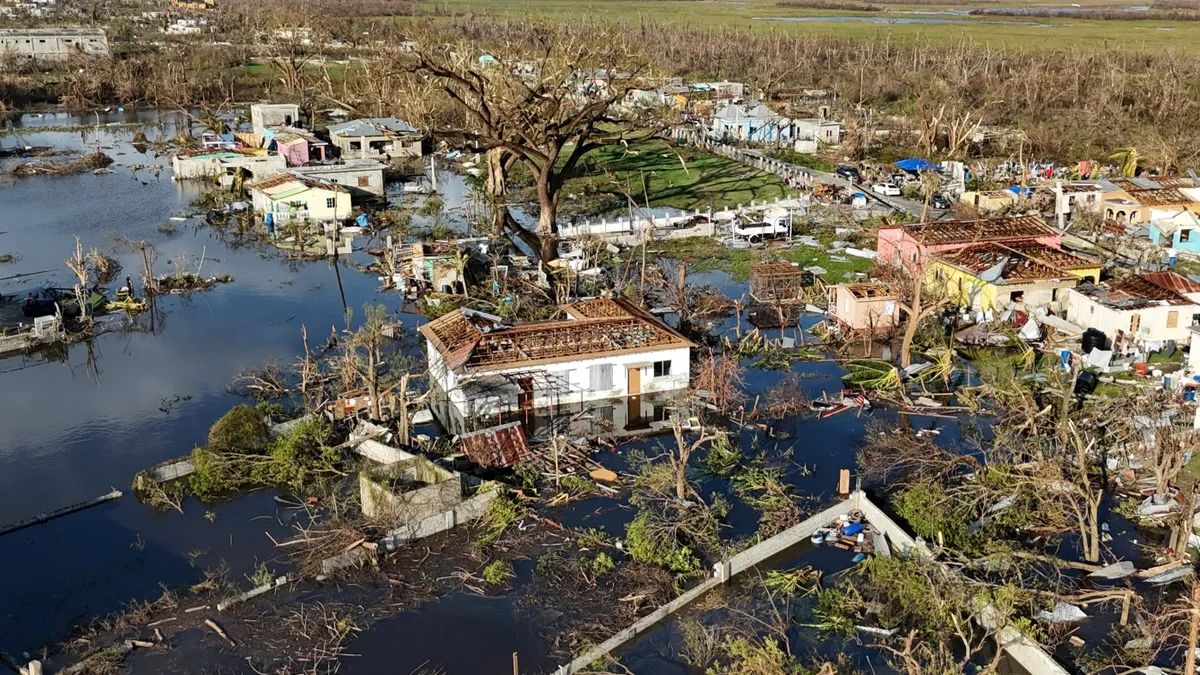
SANTIAGO DE CUBA, Cuba — On Thursday, the sound of large machinery, the whine of chainsaws, and the chopping of machetes resonated through communities in the northern Caribbean as they began the arduous process of recovering from the destruction caused by Hurricane Melissa. As residents and government workers in Jamaica worked to clear roads, the focus shifted to reaching isolated communities in the island's southeast, which suffered a direct hit from one of the most powerful Atlantic hurricanes on record.
Stunned residents wandered through the wreckage, many gazing at their roofless homes and waterlogged belongings scattered around them. Sylvester Guthrie, a resident of Lacovia in the southern parish of St. Elizabeth, expressed his despair, stating, "I don't have a house now," while clutching his bicycle, the only valuable possession left after the storm. Emergency relief flights commenced landing at Jamaica's main international airport, which reopened late Wednesday, enabling crews to distribute essential supplies such as water and medicine.
Helicopters buzzed overhead, dropping food supplies to communities where the storm had flattened homes, obliterated roads, and destroyed bridges, effectively isolating them from assistance. "The entire Jamaica is really broken because of what has happened," remarked Education Minister Dana Morris Dixon. Tragically, at least 14 people have been confirmed dead in Jamaica, with authorities anticipating that the death toll may continue to rise. In one particularly isolated community, residents pleaded for officials to retrieve the body of a victim trapped in a tree.
As the aftermath unfolded, over 13,000 people remained crowded into shelters, with reports indicating that 72% of the island was without power and only 35% of mobile phone sites were operational. "We understand the frustration, we understand your anxiety, but we ask for your patience," said Daryl Vaz, Jamaica's telecommunications and energy minister. To further aid recovery, water trucks were deployed to serve numerous rural communities not connected to the government’s utility system, as indicated by Water Minister Matthew Samuda.
In Cuba, heavy machinery was mobilized to clear blocked roads and highways, while military personnel assisted in rescuing individuals trapped in isolated communities prone to landslides. Thankfully, no deaths were reported, thanks in part to the Civil Defense's evacuation of over 735,000 people across eastern Cuba ahead of the storm. On Thursday, residents began their slow return home, with the town of El Cobre in the eastern province of Santiago de Cuba being one of the hardest hit.
El Cobre, home to approximately 7,000 people, is also the location of the Basilica of Our Lady of Charity, the revered patron saint of Cuba. Odalys Ojeda, a 61-year-old retiree, recounted the terrifying experience: "We went through this very badly. So much wind, so much wind. Zinc roofs were torn off, and some houses completely collapsed. It was a disaster." Even the iconic basilica suffered extensive damage, as Father Rogelio Dean Puerta noted, with carpentry, stained glass, and masonry all impacted.
While a televised Civil Defense meeting chaired by President Miguel Díaz-Canel did not provide an official damage estimate, officials from the affected provinces — including Santiago, Granma, Holguín, Guantánamo, and Las Tunas — reported extensive losses of roofs, power lines, and fiber optic telecommunications cables, as well as significant agricultural losses in banana, cassava, and coffee plantations. Many communities remained without electricity, internet, and telephone service due to downed transformers and power lines.
In a rare statement on Thursday, the U.S. State Department expressed readiness to assist the Cuban people in their recovery efforts. The press release indicated that the U.S. is prepared to provide immediate humanitarian assistance, both directly and through local partners who can deliver aid more effectively to those in need. However, the statement did not clarify how this cooperation would be organized or whether contact had been established with the Cuban government, with which the U.S. has a long-standing contentious relationship involving decades of economic and financial sanctions.
Hurricane Melissa also wreaked havoc in Haiti, resulting in catastrophic flooding that led to at least 30 reported fatalities and 20 individuals missing, primarily in the country's southern region. Approximately 15,000 people were still residing in shelters as officials mobilized resources for emergency relief efforts. "It is a sad moment for the country," stated Laurent Saint-Cyr, president of Haiti's transitional presidential council, as he highlighted the expectation that the death toll would rise.
The Civil Protection Agency of Haiti reported that Hurricane Melissa claimed at least 20 lives, including 10 children, in Petit-Goâve, where over 160 homes were damaged, and 80 others completely destroyed. Steven Guadard shared his heartbreaking story of losing his entire family, including four young children. Michelet Dégange, a resident of Petit-Goâve, lamented, "There is no place to rest the body; we are hungry," expressing his frustration with the lack of assistance from authorities.
When Hurricane Melissa made landfall in Jamaica as a Category 5 hurricane with maximum winds of 185 mph (295 kph) on Tuesday, it tied strength records for Atlantic hurricanes in terms of wind speed and barometric pressure. By Thursday night, Melissa had weakened to a Category 2 storm with sustained winds near 105 mph (165 kph) and was moving northeast at 32 mph (51 kph), according to the U.S. National Hurricane Center in Miami. The hurricane was situated approximately 260 miles (420 kilometers) west-southwest of Bermuda.
As the storm brushed past the southeast Bahamas on Wednesday, officials evacuated 1,400 individuals ahead of its arrival. Melissa was projected to approach Bermuda late Thursday and may strengthen again before weakening on Friday. In anticipation, Bermuda's international airport announced its closure on Thursday evening, with plans to reopen on Friday at noon, while all schools in the affluent British territory were ordered closed.